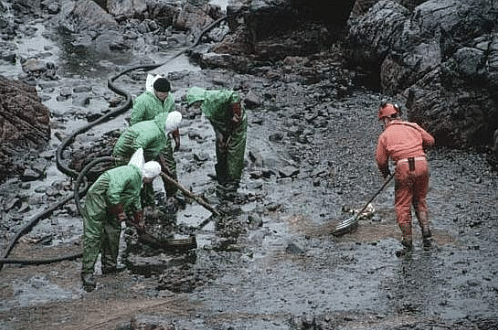Enbridge, the Canadian company poised to build the controversial Northern Gateway Pipeline, received a scathing assessment this week from the U.S. National Transportation Safety Board (NTSB) after an inquiry into a 2010 pipeline rupture in Michigan revealed the company’s mismanagement of what unfolded into a “tragic and needless” disaster.
A combination of “human error” and miscommunication culminated in the reckless release of over 843,000 gallons of Albertan diluted bitumen from the Enbridge Line 6B into the Kalamazoo River. The investigation found that 81 percent of the tar sands oil spill was the result of the company’s baffling response to rupture alerts, which prompted monitors to pump additional oil into the line – twice – rather than close the line’s remote controlled valves. The rupture went undetected for over 17 hours, leading to the most expensive onshore clean up effort in American history, with a price tag approaching $800 million.
In her opening remarks, NTSB’s chair Deborah Hersman likened Enbridge to the incompetent Keystone Kops of silent film, suggesting their bewildering response amounted to nothing more than a pantomime. “Why didn’t they recognize what was happening,” Hersman asked. “What took so long?”
According to the Board’s investigation, Enbridge knew about the ailing condition of Line 6B for at least five years before the rupture. A 2005 report identified about 15,000 defects with the aging pipeline that extends for 471-kilometers from Ontario to Indiana. Although nearly 900 of those defects had since been addressed, the NTSB found the 2010 rupture was caused by external corrosion at a site overlooked during the course of repairs.
The Board concluded that unnecessary disasters of this nature will be ongoing unless companies like Enbridge pursue pipeline safety “with the same vigour as they pursue profits.”
The NTSB findings come at a time when Enbridge’s credibility is being tested in the international spotlight. The proposed Northern Gateway Pipeline – a twin pipeline nearly 3 times the length of Line 6B – would carry 525,000 barrels of tar sands oil and 193,000 barrels of condensate per day across British Columbia’s mountainous terrain, traversing some 800 waterways before reaching the province’s coast where the product will be shipped to Asian markets through some of the northwest’s most notoriously treacherous ocean passages.
Greenpeace Canada Climate and Energy Campaigner Mike Hudema suggests the significance of the NTSB’s findings should bear down on the current pipeline proposals under review in Canada.
“Today’s damning findings from the NTSB reveal that Enbridge exploited weak regulation. They knew about the broken pipeline’s corrosion for five years and did nothing about it. Canadian officials must wake up and say no to Enbridge’s tar sands pipelines. This should be the last warning signal we need that Enbridge cannot be trusted to build a tar sands pipeline through the largest intact temperate rainforest left on the planet. This tar sands pipeline should never be built.”
In response to the NTSB findings Enbridge said it has “already implemented, in 2010 and 2011, appropriate operational and procedural changes based on our own internal investigation,” adding, “as a result of our detailed investigation into the accident, and as part of our ongoing continuous improvement efforts, we have taken steps to address lessons learned and make incremental improvements aimed at preventing a similar accident from happening again in the future.”
In addition to finding “pervasive organizational failures at Enbridge,” the NTSB panel also found fault with industry regulators. Hesman cautioned that the “accident was the result of multiple mistakes and missteps by Enbridge but there is also regulatory culpability.” She added, “delegating too much authority to the regulated [companies] to assess their own system risks and correct them is tantamount to the fox guarding the hen house.”
“Regulators need regulations and practices with teeth – and the resources to enable them to take corrective action before a spill, not after.”
Yet the regulatory landscape is about to change in Canada with the implementation of the newly passed omnibus bill C-38. With a weakened capacity for environmental review and oversight, Canadian regulators may not have the legislative backing necessary to prevent accidents before they happen.
And given Enbridge’s aggressive lobbying over the months leading up to the passing of bill C-38 – seeking “regulatory streamlining…for pipeline construction,” “improved efficiencies to the environmental assessment processes” as well as amendments to “the proposed ban on oil tanker traffic” and “greenhouse gas regulations in respect of quotas that affect the energy and pipeline industries” – the current political climate appears to be in favor of letting industry run amok at a time when what we need to be is cautious.
In the words of NTSB chair Hesman, the board’s findings should “force us to ask hard questions of this vital industry.”
With the final hearings for the Joint Panel Review of the Northern Gateway Pipeline scheduled to begin this September, we can only hope such hard questions are asked.
Image Credit: Northern Insights
Subscribe to our newsletter
Stay up to date with DeSmog news and alerts






